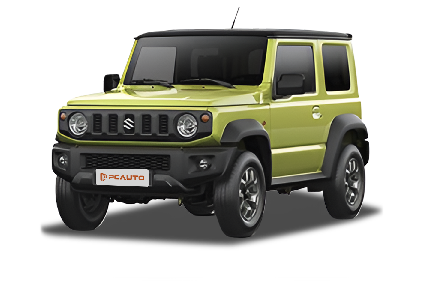Q
Where is the Suzuki jimny made?
The Suzuki Jimny, a classic compact off-roader, has its main production base at the Suzuki Iwata plant in Shizuoka Prefecture, Japan. This facility is responsible for manufacturing models destined for the domestic Japanese market as well as Europe, leveraging advanced manufacturing techniques and strict quality control standards to ensure vehicle reliability and durability. For the Malaysian market, the Jimny is primarily imported, although some models are also produced through local assembly (CKD) to meet regional demand. This approach not only reduces tariff costs but also enables a quicker response to local consumer preferences.
Since its initial launch in 1970, the Jimny has undergone several upgrades while maintaining its iconic body-on-frame construction, part-time four-wheel-drive system, and compact, agile dimensions. These characteristics allow it to excel in Malaysia’s challenging terrains, including rainforests and mountain roads, making it a popular choice among off-road enthusiasts. Notably, in 2023, the Jimny introduced a special edition model that further optimized its suspension system and exterior design, enhancing its competitiveness in this niche market.
As a small SUV that balances daily commuting with outdoor adventures, the Jimny continues to attract young consumers and off-road aficionados in the Malaysian automotive market, thanks to its unique positioning and affordable pricing.
Special Disclaimer: This content is published by users and does not represent the views or position of PCauto.
Related Q&A
Q
How heavy is a Suzuki Jimny?
The Suzuki Jimny, a classic compact off-roader, varies in weight depending on the model and configuration. According to official data, the currently available fourth-generation Jimny (2023 version) in its three-door variant has a kerb weight ranging from approximately 1,060 to 1,110 kilograms. Meanwhile, the recently launched five-door long-wheelbase version sees an increase in weight due to its extended body and upgraded features, bringing its weight to around 1,190 to 1,210 kilograms. The exact figures depend on factors such as the drivetrain configuration (two-wheel or four-wheel drive), optional packages (like metal bumpers or roof racks), and additional equipment.
The Jimny's lightweight design benefits from its body-on-frame structure and ladder frame. This configuration not only ensures off-road rigidity but also effectively controls weight, granting it excellent maneuverability and fuel efficiency in rugged terrains—particularly suitable for Malaysia’s mountainous landscapes and rainforest traversing needs.
In terms of power, the Jimny is equipped with a 1.5-liter K15B naturally aspirated engine that pairs efficiently with the ALLGRIP four-wheel-drive system. Although its power figures may not be particularly impressive, the lightweight body allows it to deliver sufficient traction and recovery capability. Notably, the Jimny's popularity in the Malaysian market is closely linked to its low maintenance costs and high modification potential. Many owners opt to add off-road skid plates or rooftop tents, which can increase the vehicle's weight by an additional 50 to 100 kilograms. It is advisable for owners to be mindful of the vehicle's weight limits when modifying to ensure safety.
Q
How to connect phone to Suzuki Jimny?
The steps to connect your phone to Suzuki Jimny are typically as follows: Firstly, turn on the car's Bluetooth, which can usually be found in the settings menu. Then turn on the Bluetooth on your phone, find "Suzuki Jimny" in the list of available devices, and click to pair. Once the pairing is successful, the phone and the vehicle will be connected and you can use the related functions of the phone via the car system, such as making calls, playing music, etc.
Q
What type of car is the Suzuki Jimny?
The Suzuki Jimny is a compact, hardcore off-road vehicle. It is known for its small size, flexibility and excellent off-road capabilities. Its appearance features uniqueness, with a compact body and strong lines. In terms of power, it usually provides sufficient torque output to cope with various complex road conditions. The interior configuration is practical, focusing on functionality. In Malaysia, the Suzuki Jimny is loved by many consumers, especially those who pursue individuality and enjoy outdoor adventures.
Q
How many cylinders of Suzuki Jimny?
The Suzuki Jimny typically features a 4-cylinder design. In the Malaysian car market, the Suzuki Jimny is favored by some consumers for its compactness, flexibility and off-road capabilities. The 4-cylinder configuration provides a balanced power output and fuel economy for the vehicle.
Q
What is the price of Suzuki jimny 2023?
The price of Suzuki Jimny 2023 in Malaysia may vary depending on the configuration and sales region. Generally, its price is in a certain range of RM 158,900 to 168,000. It's noted that the actual price may be affected by factors such as market supply and demand, promotional activities, etc.
Q
What are the best tyre for Suzuki Jimny?
The best tire choice for the Suzuki Jimny in Malaysia depends on various factors. Popular high-quality tire brands like Michelin, Bridgestone, and Continental can all provide good performance. If you frequently drive on city roads and value comfort and low noise, the Michelin Primacy series would be a good choice. If you have significant off-road needs, the Bridgestone Dueler or Continental CrossContact series can offer better traction and durability. However, the final decision should take your driving habits, budget, and local road conditions into account.
Q
How to open the hood of Suzuki Jimny ?
To open the hood of a Suzuki Jimny, you usually first find the hood release lever on the lower left side of the driver's seat and gently pull it. Then walk to the front of the car, in the middle position at the front end of the hood, you can feel a movable latch, which can be moved to the right, and then the hood can be lifted. You need to pay attention to support it when you lift the hood to prevent damage resulting from sudden falling.
Q
How many seats in Suzuki Jimny?
The Suzuki Jimny usually has a 4-seat layout. This car is favored by some consumers for its compactness, flexibility, and certain off-road capabilities. The 4-seat design not only satisfies the daily travel , but also ensures the reasonable use of the interior space.
Q
How to open the fuel tank cover of Suzuki jimny?
The opening method of the Suzuki Jimny's fuel tank cover is usually quite simple. When the vehicle is unlocked, you can find a button or handle with a fuel tank symbol on the side of the vehicle, which is close to the fuel tank. Simply press or pull it lightly to open the fuel tank cover. If you still can't find or open it, it is recommended to refer to the vehicle's owner's manual for more precise and detailed information.
Q
What's the price of Suzuki Jimny 2024?
The price of the Suzuki Jimny 2024 in Malaysia may vary depending on the configuration and the dealer. Generally speaking, its price is within a certain range. However, for a specific price, it is recommended that you consult your local Suzuki dealer or visit relevant car sales websites for the latest and accurate information.
Latest Q&A
Q
How to Calculate the Load Capacity of Jaecoo J7? Get Idea Here!
To calculate the load capacity of the Jaecoo J7, the primary method is to subtract the vehicle's curb weight (kerb mass) from its gross vehicle weight rating (GVWR) to determine the maximum permissible load. Typically, the Jaecoo J7 has a GVWR ranging from 2,200 to 2,500 kg, while its curb weight falls between 1,600 and 1,800 kg, resulting in a maximum payload capacity of approximately 400 to 700 kg. The exact figures should be verified against the official manual.
When calculating the load, ensure it includes the weight of passengers, luggage, and any additional accessories. Proper load distribution is advised to avoid overloading, which could compromise handling and braking performance. For frequent cargo transportation, compare the axle load limits and conduct dynamic balance checks to ensure driving safety.
Q
What Is Jaecoo J7? Here's a Full Introduction for You
The Jaecoo J7 is a C-segment vehicle, available in the 2024 fuel-powered version (including 2WD and AWD) and the 2025 PHEV version. The fuel-powered version is equipped with a 1.6L turbocharged engine, with a maximum power of 145kW and a maximum torque of 290N·m. It is paired with a 7-speed dual-clutch transmission. The official 0 - 100km/h acceleration times are 9.9 seconds (2WD) and 9.2 seconds (AWD), and the combined fuel consumption figures are 7L/100km (2WD) and 7.7L/100km (AWD). The prices are RM 138,800 (2WD) and RM 148,800 (AWD).
The PHEV version combines a 1.5T turbocharged engine with an electric motor. The system's combined power is 255kW, and the combined torque is 525N·m. It has an all-electric range of 106 kilometers and is priced at RM 158,800.
The vehicle is 4500mm long, 1865mm wide, and 1670mm (PHEV) or 1680mm (fuel-powered version) high, with a wheelbase of 2672mm. It features a rugged exterior. Inside, there's a 10.25-inch instrument cluster and a 13.2-inch (fuel-powered 2WD) or 14.8-inch (fuel-powered AWD and PHEV) center console display. It's also equipped with a Sony audio system and other features. The safety configuration is comprehensive, including ABS, vehicle stability control, and so on.
Q
What Is the Tire Size of Jaecoo J7? Check Standard Here
The tire specifications vary among different versions of the Jaecoo J7. Both the 2024 Jaecoo J7 2WD and 2024 Jaecoo J7 AWD are equipped with R19 tires for both the front and rear. This specification strikes a good balance between stability and comfort during daily driving and is suitable for various road conditions. The 2025 Jaecoo J7 PHEV 2WD is equipped with 235/50 R19 tires on both the front and rear. These tires are wider, which increases the contact area with the ground. As a result, they offer relatively stronger grip and perform better in terms of acceleration, braking, and handling, providing the vehicle with better driving stability. Tire specifications have a significant impact on vehicle driving. The appropriate specification not only affects driving safety but also influences the vehicle's handling, comfort, and fuel economy.
Q
What Are the Problems of Jaecoo J7? Learn Before You Buy
Before considering purchasing the Jaecoo J7, there are several issues worth paying attention to. Some drivers have reported that the torque distribution of this vehicle across the entire speed range seems uneven, and the engine runs a bit roughly at low speeds. The gearbox hesitates when starting from a standstill or with moderate throttle input. Additionally, the trunk capacity of the J7 is 500L, which is relatively small and not very user - friendly for those with a high demand for luggage loading.
However, it also has many advantages. It is equipped with abundant safety features, including standard body stability control, multiple airbags, and lane - change assist. The interior configuration is also quite comfortable, with a multi - function steering wheel, HUD head - up digital display, and zone - controlled air conditioning. Moreover, it offers a variety of drive modes and power types, which can meet the needs of different consumers. Consumers can make a decision based on their own requirements.
Q
What's the Boot Capacity of Jaecoo J7?
The boot capacity of Jaecoo J7 is 500 liters, and the space can be expanded to a larger one when the seats are folded down, offering great convenience for trips. If you need to load daily shopping items, travel gear, or sports equipment, the regular 500 - liter capacity can basically meet your needs. When it comes to moving large items like bicycles or furniture, which are often irregular in shape, you can fold down the rear seats in proportion to create a relatively flat space. This way, you can easily fit these items in, greatly enhancing the vehicle's practicality and cargo - carrying capacity. Whether it's a family trip or personal daily use, the Jaecoo J7 can well handle different loading requirements in various scenarios.
View MoreRelated News

Suzuki Jimny's Trusted 4WD System: Unleash Off-Road Thrills
Kevin WongMay 13, 2025

Jimny Nomade Japan released, over 50,000 orders in 4 days, consumers need to wait for 3.5 years
MichaelFeb 5, 2025

Suzuki Jimny Arctic Launch: Limited Time Offer to Save 7000 Ringgit!
Kevin WongNov 18, 2024

Getting More Expensive, 2024 Suzuki Jimny Starts at RM 174,180. Is it a Financial Wizard?
LienApr 18, 2024

All-New Suzuki Swift Sport Will Debut with Revolutionary 1.4T Engine
MichaelJun 3, 2025
View More
















Pros
Cons